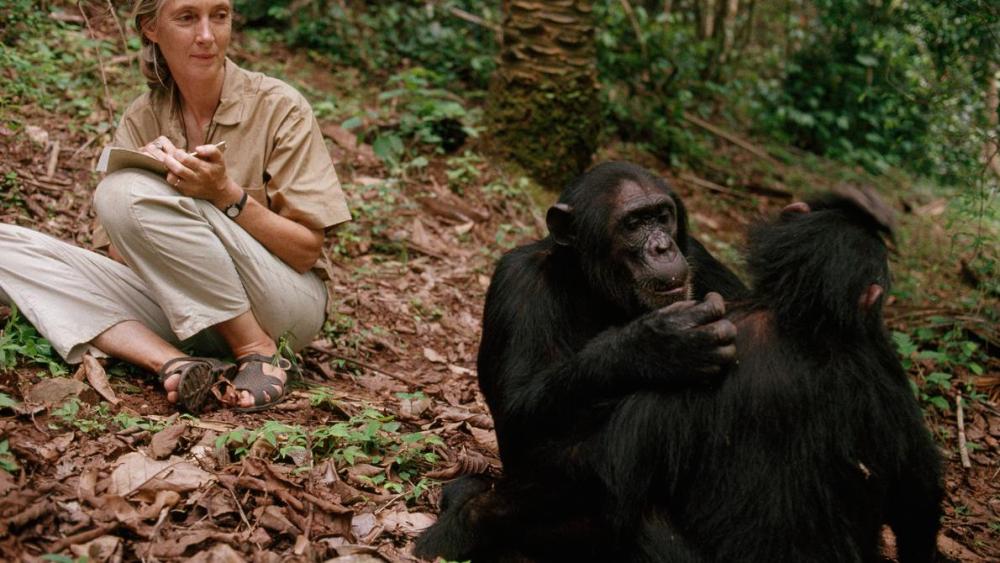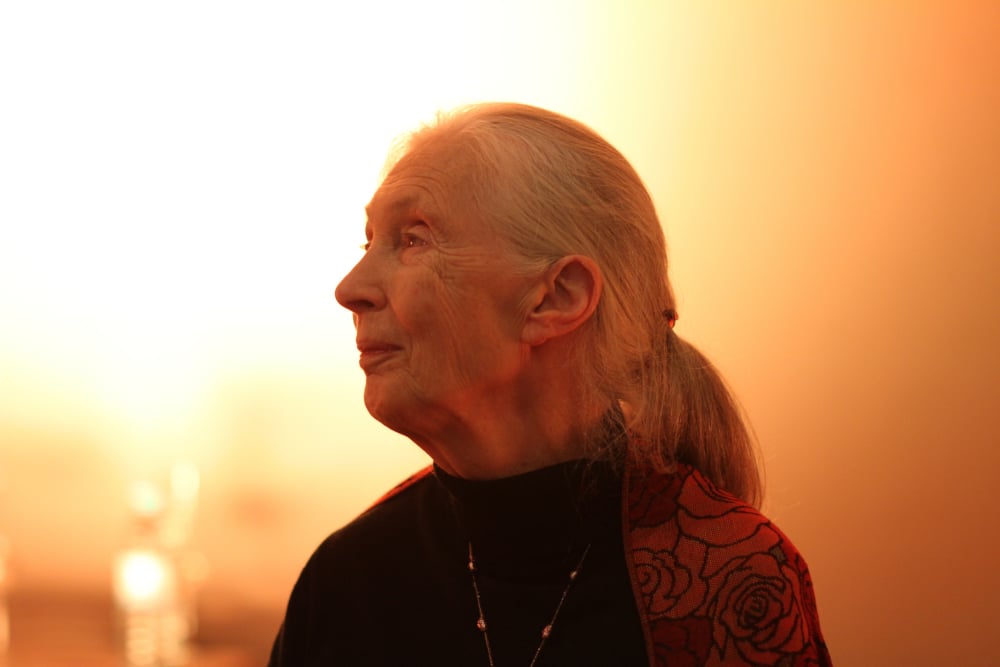Does Jane Goodall ever get mad?
For someone who started her career with the intention of studying animals, the woman has spent an inordinate amount of time with people. And lord knows humans can be annoying — and wantonly destructive. A study released this week revealed that since 1970 humans have destroyed more than 60 per cent of animal species on Earth.
How do you hold out hope for humanity?
But that’s exactly what the good Dr. Goodall is doing. The renowned primatologist was recently here to speak at the Vancouver International Film Festival, in concert with a screening of the documentary Jane about her life. We met, and talked about a wide array of subjects, everything from what she calls the Kavanaugh situation — “his behaviour in court, all staged for effect” — to Heinrich Himmler and the SS. Coming out on the street afterwards, I thought: the woman is 84. If she can keep on trucking, so can you.
Despite a travel and speaking schedule that would break most people she is resolutely cheerful, dressed in a soft pink sweater with a silver pendant in the shape of the African continent around her neck. As the interview starts, I get a little star-struck and start to babble insanely. After it ends, I look at my scrawled notes and think, “What the hell was I was talking about?”
But I’m sure this is not the first time Goodall has experienced people losing their proverbial shit in her presence. There’s actually a term for it — The Jane Effect. When people first meet her they often burst into tears or, as in my case, can’t stop talking.
I imagine this must be trying, but Goodall said in her festival talk her mission is to spread the message about biodiversity, and this often requires being subjected to batteries of weeping, babbling human beings. Dr. Goodall travels more than 300 days a year, balancing the requirements of more than 25 chapters of the Jane Goodall Institute and the demands of staff, students, sponsors, media types and the occasional documentary filmmaker.
Jane, the recent film about her life directed by Brett Morgen, chronicles Goodall’s love affair with Hugo van Lawick, her first husband and the father of her son, and her passion for the chimpanzees and the forests of Tanzania. Having watched the film a number of times I am still struck by the immediacy of the experience, captured in gloriously saturated 16-mm celluloid.

Goodall says Morgen’s film “takes me right back into my 26-year-old skin.” There she is, with wheat-coloured hair, sun freckles, and long legs. It’s little wonder that the world took one look at her and fell immediately in love, as did van Lawick, a wildlife photographer assigned by National Geographic to document her research. Almost six decades later you can see why men, from Leonardo DiCaprio to Brett Morgen, go a little cuckoo around her. She is exactly what you expect from the legions of books, films and photo essays — calm, thoughtful, passionate and very funny, and still with that fine pair of legs.
But the scale and scope of the issues Goodall faces have grown monstrous since she first journeyed to Gombe National Park in 1960. As the recent study showed, we are in the midst of a major extinction event brought on by human activity. How does one keep going on in the face of such unremitting bleakness?
I try not to ask these questions for fear of wailing like a lost child. But in speaking about her work, Goodall often talks about parents and children. The Jane Goodall Institute of Canada, founded in 1994,* is dedicated not only to the preservation of animals, but also to the betterment of the human species, starting with its youngest members. Since its start with some 12 Tanzanian high school students, the Roots & Shoots program has expanded around the globe and currently includes chapters in more than 80 countries with 150,000 members. Grassroots action, all precipitated by this slender reed of a woman who saw in chimpanzees a shared kinship.
As she says in the documentary: “They, like us, needed friendly contact and reassurance... Staring into the eyes of a chimpanzee, I saw a thinking, reasoning personality, looking back.”
Even as a Donald Trump or a Jair Bolsonaro, can wreak unprecedented havoc, a George Monbiot or a Jane Goodall can singlehandedly change the environment for the better.
Goodall had originally been assigned to study the chimpanzees by Dr. Louis Leakey, who wanted to use animal studies to learn more about early humans. (Humans and great apes share 97 per cent of their DNA.) In Goodall’s case, although she lacked a degree or much experience in the field, she was young, eager, and open to new ways of looking at animals.
In light of this, I’m curious to know if she thinks women approach science differently. When she first started her work the roles of men and women were prescribed and hidebound. “I expected to be married,” she says. “To do my PhD.” The idea of a young single woman setting off for Africa to study animals in the wild was almost inconceivable. The initial trip to Gombe required the presence of Goodall’s mother, who acted as helper, chaperone and companion.
What emerged from Goodall’s fieldwork took everyone by surprise. The conflation of human consciousness and the animal mind caused uproar in the scientific community and in the media, and the concept of sentience among animal beings continues to be a difficult, perhaps even impossible, thing to address. To admit that animals have emotions, and suffer pain, means changing everything from farming practices to conservation.
Goodall says that things like factory farming pose a huge challenge, especially when humans insist on treating some animals like friends (dogs) and others as food (pigs). But change begins with empathy and emotion. We talk about the mother killer whale that spent 17 days nudging her dead baby to the ocean’s surface. It was almost unbearably painful to witness, but also seemed a signal from the animal to the human world about the emotional pain that animals endure, as well as the dire circumstances they face with a dwindling habitat.
In spite of the grim news for the environment from the U.S., and now Brazil, where a newly elected presidential nightmare threatens to sell off the Amazon rainforest and jettison all Indigenous land rights, Goodall argues that there is ample reason for hope.
“There is a great deal of optimism, and so many great projects, kindness to animals, people devoting their lives to eradicating poverty, environmental design. It’s important not to give up.”
In this culture also plays a critical role. The film Jane pays attention to the literary heroes of Goodall’s youth, from Dr. Doolittle to Tarzan of the Apes. Although books may seem a slight weapon to wield against the onslaught of global devastation, a pen against a howitzer, the effects can be long lasting, affecting generations after generations. I ask Goodall which writers, artists and activists continue to inspire her.
“Graham Greene, George Orwell, Rachel Carson, who wrote Silent Spring. I’ve read a lot about the Holocaust,” she says. “Animals are not capable of real evil. Real evil is planned out in cold blood.” She recounts a recent visit to the Berlin Holocaust museum and talks about being struck by figures such as Heinrich Himmler, whose exacting plans informed the beginning of the Holocaust.
In the face of atrocities committed by humans on each other as well as on the rest of the natural world, I wonder how she manages not only to keep on her own punishing schedule but also to inspire the generations who have grown up venerating her. Surely such relentless attention, not to mention responsibility must become unbearable sometimes.
“Do you find being around people just exhausting?” I ask, but she just gives me a gentle gaze like I’ve asked a rather dumb question.
After all, much of her work consists of simply being herself, allowing people’s attraction to her to morph into a greater dedication to doing good. Even something like social media can be an extremely useful tool, breaking down isolation and bringing about change on an unprecedented scale.
Goodall describes how pressure can be brought to bear in multiple ways, from the products we buy to the choices we make.
But it often comes down to the indomitable human spirit, she says, citing Terry Fox and Chris Koch as examples of kindness and perseverance. In the animal world, the return of the Vancouver Island marmot, once reduced to tiny numbers, as well as the resurgence of the whooping crane, a species that was once considered emblematic of extinction, are powerful indicators of nature’s resiliency.
Where there is life, there is hope. But can humans ever really give up their sense of superiority?
“We’ve come to understand the intelligence of the octopus, of bumblebees. My greatest childhood teacher was my dog,” Goodall says. She is passionate about the current moment, and in particular the spectre of climate change, as bleak as things currently seem.
“There is this window of time around the world in the U.S., Australia, and the U.K. for turning things around,” she says. “Profit diminishes the way we look at the world,” Goodall adds, but she has a “renewed sense of hope that human beings can learn to live in harmony in our own daily lives.”
In Goodall’s talk at the film festival, one statement leapt out. She was asked how she keeps going despite the challenges.
“It’s almost as though I was put here for a purpose, and that there was a mission. Going through my life, and I’ve often done this, there were points along the journey where all I had to do was make the right decision, and I think, looking back, I did make the right decision, but what kept me going was determination and obstinacy.”
The endless work of saving the world goes on, and Goodall offers important lessons. Kind, forthright, and stubbornly refusing to accept any limitations, Goodall offers another path.
First and foremost, hers is a love story. Not simply with other creatures — child, husband, chimpanzees — but with the planet itself. Love is a transformational force, and it carries with it the seeds of ongoing, unrelenting change, stubborn as a dandelion.
*Date corrected Nov. 2 at 12:40 p.m. ![]()
Read more: Environment

















Tyee Commenting Guidelines
Comments that violate guidelines risk being deleted, and violations may result in a temporary or permanent user ban. Maintain the spirit of good conversation to stay in the discussion.
*Please note The Tyee is not a forum for spreading misinformation about COVID-19, denying its existence or minimizing its risk to public health.
Do:
Do not: